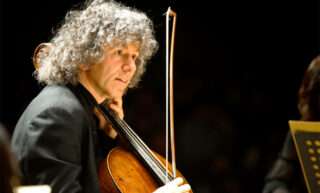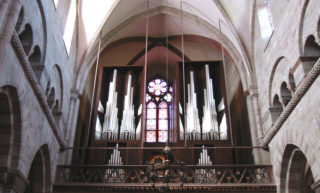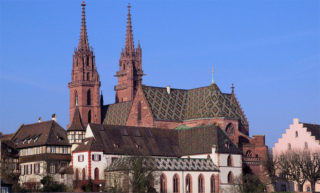Resurrection
Sinfonieorchester Basel
22 April 2020
Christina Landshamer, Soprano
Catriona Morison, Mezzosoprano
MDR-Rundfunk Choir
Mira Grazinyte-Tyla, Conductor
Giovanni Gabrieli / Bruno Maderna - Canzone a tre cori
Arnold Schönberg - Friede auf Erden
Gustav Mahler - Symphony No. 2
For the penultimate concert in the Basler Münster, before the return to the Stadtcasino, the SOB honors the Italian composer Bruno Maderna (1920-1973) for the second time this season. On the programm is his transcription for orchestra of Gabrieli’s Canzone a tre cori. The concert will take place, appropriately, just one day after Maderna’s hundredth birthday. The original piece by Gabrieli (born between 1554 and 1557, died in 1612) was a song for three choirs, making it a fitting appetizer for the remainder of the concert. The main course, Mahler’s second symphony, features a choir in the last movement and Arnold Schönberg’s Friede auf Erde (Peace on Earth), the entremets if you wish, is a composition for a cappella choir based on the Swiss poet Conrad Ferdinand Meyer’s eponymous poem.
The concert more or less coincides with Easter when the Christian world celebrates the resurrection of Jesus. Resurrection (or Auferstehung) is also the title of Mahler’s second symphony. The name refers mostly to the approximately 35-minute long last movement, in which the Last Judgement is announced. The graves open up, the earth shakes, people ¬¬– rich and poor – arise without any discrimination, and finally we hear a beautiful fifth in the horns echoed by a second group of horns (reminding us of the tattoo that marks the end of the day or in this case perhaps the end of time), until from out of nowhere the bird-like flute and piccolo introduce the choir that sings: “Auferstehen”.
Four other movements precede the final movement. The first movement, composed in 1888, was originally a stand-alone Totenfeier or funeral ceremony, which leads the listener to inevitably reflect on matters of life and death. The atmosphere in the second movement forms the antithesis to the first: using the rhythm and melody of a simple dance tune (a Ländler), the composer depicts an utterly optimistic moment in the deceased’s life, when death seems to be non-existent. The third movement captures the gloomy notion of life being hollow and inconsequential, after which in the fourth movement – a hauntingly beautiful and meditative song for alto and orchestra from the Wunderhorn cycle – a lonely naïve soul dreams of how God gives her a little light that will lead her back to the blessed eternal life.
In his symphony Mahler (1860-1911) addresses some of the major questions of life. Their sheer extent and impact is reflected in the large number of musicians involved, including several offstage.
By introducing a choir and soloists, Mahler’s second symphony was evidently inspired by Beethoven’s revolutionary ninth, the first symphony that incorporated vocal elements. Although we don’t know of any link between Schönberg’s piece and Beethoven’s ninth symphony, both composers were groundbreaking in their days, and Peace on Earth and the Ode to Joy (Alle Menschen werden Brüder) seem to be messages in the same vein.
And so, again in this concert, we come back to Beethoven, the composer who loomed large over following generations of composers and whose 250th birthday we celebrate this year. However, in this concert we are commemorating Bruno Maderna in the first place.
These English program notes have been published in the magazine (No. 7, 2019/2020) of the Sinfonieorchester Basel.








Comments